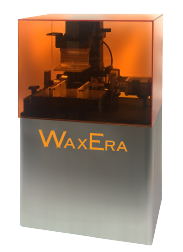Wax Paste Material for Jewelry Casting

Latest News
June 26, 2015
The jewelry market has begun embracing 3D printing as a way to more easily create castable models, but there are some drawbacks to using traditional resin printing materials for these applications. EnvisionTEC may have come up with a solution. The company has announced what it is calling the first direct light projection (DLP) printer that uses curable paste as a printing material. The company is initially targeting the printer at jewelry manufacturers because it can create detailed, non-brittle wax models from digital jewelry STL design files.
The Perfactory WaxEra can print a light, curable paste instead of liquid-based polymers. The E-Wax material is a wax paste with a photosensitive polymer binder for jewelry investment casting. The company unveiled the new printer and material at the JCK jewelry show at the end of May.
While some jewelers have begun using stereolithography 3D printing technology as an alternative to traditional lost-wax casting, the resins used in these systems don’t melt as reliably as wax. Using DLP SLA technology to cure a wax paste opens up the possibility of investment casting of larger jewelry pieces of any wall thickness. It can also reduce porosity, according to EnvisionTEC.
“We are proud to deliver the very first Digital Light Projection technology based 3D printer that can print with a paste material, opening up the possibility to 3D print using highly filled materials,” said Al Siblani, EnvisionTEC CEO in a press release. “These new highly filled paste materials will allow EnvisionTEC to penetrate new markets, and deliver 3D printing solutions not previously available in the 3D printing space. Whether you want a highly filled ceramic part for high temperature resistance or a highly filled wax part for direct investment casting, the WaxEra brings 3D printing into a new ERA by delivering innovative 3D printing solutions to an expanding selection of new markets.”
The printer can connect to a workstation via a USB cable. The 30-lb. device has a build envelop of 40mm by 30mm by 100mm, and a 0.0012-in. resolution.
Source: BusinessWire
Subscribe to our FREE magazine, FREE email newsletters or both!
Latest News
About the Author
Brian Albright is the editorial director of Digital Engineering. Contact him at [email protected].
Follow DE





